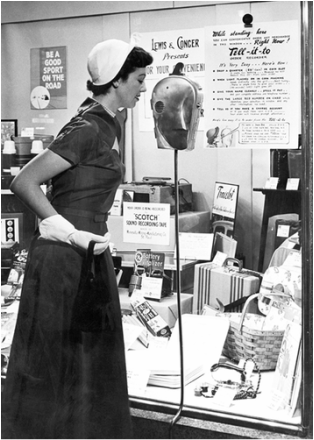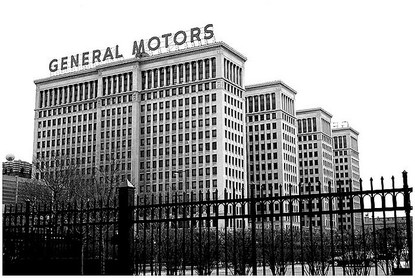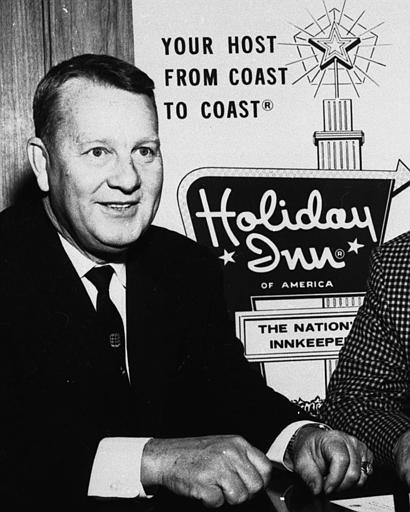Consumer Demand Spurs Economic Growth

During World War II, Americans had saved billions of dollars. Flush with cash, they were ready to go on a spending spree as soon as factories could convert from war production to consumer goods. This surge in consumer demand encouraged businesses to expand production. By 1955, the United States, with only 6 percent of the world’s population, was producing almost half of the world’s goods.
As the economy grew, incomes rose. Real income is income measured by the amount of goods and services it will buy, regardless of inflation. By the mid-1950s, the average American family had twice as much real income to spend as the average family of the 1920s had. And spend it they did.
Not only were Americans spending more money than ever before, they were also spending it in different places. In the past, most people had bought their goods in stores lining the main street of town. By the mid-1950s, however, suburban shopping centers were luring consumers away from downtown shopping districts. Shopping centers offered customers easy parking and a wide array of shops to browse, often in air-conditioned comfort. By 1964, there were more than 7,600 shopping centers across the United States.
Businesses used methods pioneered during the 1920s to encourage consumers to keep on spending. One method was slick advertising campaigns. By 1955, businesses were spending $8 billion a year on ads that encouraged consumption.
Another method was to offer consumers easier ways to buy now and pay later. Large stores issued charge cards that allowed their customers to charge goods to an account rather than pay cash. By 1960, Sears Roebuck had more than 10 million accounts, or one for every five families. In 1958, American Express launched the first all-purpose credit card that could be used in stores, hotels, restaurants, and gas stations.
A third method used to encourage consumption was called planned obsolescence. Brooks Stevens, the industrial designer who popularized this term, defined it as a way to create “the desire to own something a little newer, a little better, a little sooner than is necessary.” Businesses using this method looked for ways to make what a consumer bought today seem obsolete, or out-of-date, after a fixed period of time. Clothing companies did this by introducing new fashions every season. As they did so, last season’s garments, although still usable, looked dated. Automobile companies did the same thing by changing the styling of their cars every year.
The Economy begins to shift from goods to services
As the majority of Americans came to depend on cars for transportation, they demanded more and better roads. State and federal lawmakers responded by funding new highway construction programs. The most ambitious was a program authorized by Congress in 1956 to construct a nationwide interstate highway system. The goal of this system was to connect major cities around the country by a network of super highways.
By 1960, about 10,000 miles of interstate highway had been constructed. Today, the system has about 45,000 miles of highway. The interstate highway system benefited the country in many ways. It made travel by road over long distances both faster and safer. It created economic opportunities for new industries that provided services, rather than manufacturing goods, such as gas stations, motels, and restaurants, which sprang up at interstate exits. By improving access to all parts of the country, the system gave people more choices as to where to live, work, shop, and vacation.
General Motors

The biggest and best-known manufacturing company was the automaker General Motors. In 1955, GM became the first U.S. corporation to earn more than $1 billion a year. It accomplished this feat by producing and selling as many cars as all of its competitors produced combined.
An important factor in GM’s success was an improved relationship with its workers. In 1948, GM signed a historic agreement with the United Auto Workers union.
The agreement guaranteed that GM workers would receive regular wage hikes tied to a cost-of-living index.
A cost-of-living index measures differences in the price of goods and services over time. If inflation pushes prices up, the index measures by how much prices went up.
Fortune magazine called the agreement “the treaty of Detroit.” It brought GM years of labor peace.
Gas Stations
By the 1950s, the average American family had at least one car and that car was a large gas guzzling source of pride. The heyday of the full service gas station reached its peak in those post World War II years.
Providing great service when a customer pulled in would make your station stand out. Customers would then come back. Many of these mom and pop stations would offer free postcards, key chains, toys and sodas for the kids, S&H Green stamps and of course maps. All this was to make your gas fill-up even more desirable and memorable.
As the number of gas stations grew so did competition. In 1947 Frank Urich had a different idea on how to get gas customers. He opened the first self-service gasoline station in Los Angeles.
His slogan was,”Save 5 cents, serve yourself, why pay more?” The station featured rows of shiny new pumps and girls on roller skates who skated around to collect money. His place became very popular, especially among the men. Getting gas at full service stations took longer. At Frank’s place you could get in and out in a flash.
McDonalds
As the economic boom continued, new service industries began to compete for the consumer’s dollar. One was the fast-food service industry. In 1954, a go-getter named Ray Kroc visited McDonald’s Famous Hamburgers in San Bernardino.
He was amazed by what he saw. An hour before lunch, there was already a long line of customers waiting to be served.
Kroc asked people in line what they liked about the restaurant. They replied that it was clean, fast, and cheap. In addition, the burgers tasted good, and it was not necessary to tip anyone.
Kroc convinced the McDonald brothers to hire him as a franchising agent. A franchise is an agreement to operate a business that carries a company’s name and sells its products.
The next year, he opened his own franchise restaurant in Des Plains, Illinois. Like the original, Kroc’s McDonald’s was wildly successful. It was especially attractive to families with young children who did not feel comfortable in more formal restaurants.
Under Kroc’s leadership, hundreds of McDonald’s soon dotted the landscape. By 1963, the fast-food chain had sold more than 1 billion hamburgers.

Holiday Inn
Another new service industry, the motel chain, was inspired by a summer driving trip. In 1951, Kemmons Wilson, a homebuilder in Tennessee, took his family on a car trip to Washington, D.C. Day after day, he faced the problem of finding a decent place for his family to spend the night.
Motels at that time were independent, mom-and-pop operations. Some were clean. Others were filthy. Some charged extra for children. Others did not. The only way to find out was to go from one motel to the next.
A frustrated Wilson finally turned to his wife and announced he was going into the motel business. She asked how many motels he planned to build. “Oh, about four hundred,” he answered. “That ought to cover the country.”
His motels would be clean, affordable, easy to find, and family-friendly. “If I never do anything else worth remembering in my life,” he added, “children are going to stay free at my motels.”
Wilson returned home and built his first Holiday Inn. After franchising his chain, the number of Holiday Inns grew rapidly. Other chains, such as Best Western and Howard Johnson’s, also began to expand. By the 1960s, the motel chain had become a fixture on America’s highways.

This page is courtesy of the educational website THE 1950’S: AN AGE OF AFFLUENCE . We applaud them for such a great & thorough job showing us life after wartime ( World War II ) in the 1950s
Your viewing the part on CONSUMERISM. Please check out other very interesting sections of their site including POST WAR LIFE, SUBURBIA, and FAMILY LIFE STYLE.
FOR MORE: Please follow the link above for more fascinating history of The U.S.A. 10 Amazing Years, 1947–1957: A Decade of Miracles.
Thanks much!
Mid Mod Scout
